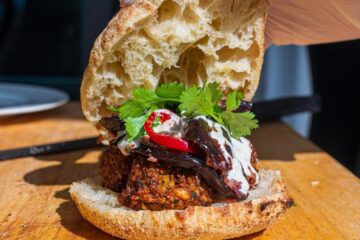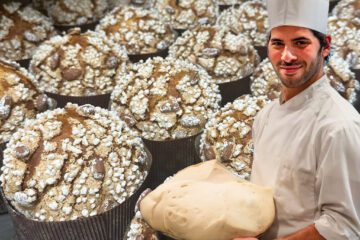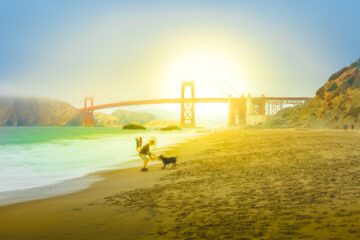What Makes A San Francisco Chef Great?

The book, published in early 1984, went for $9.95 and featured a baker’s dozen of San Francisco chefs. (Paolo Bicchieri)
There’s relatively good food, even subjectively good food, then there’s Marnee Thai. The shotgun-style restaurant is lit in warm orange and servers are fast, attentive, prophetic. The coconut cakes arrive plentiful and hot, creamy and studded with squash and corn. It’s a restaurant so dank owner Chai Siriyarn opened Marnee Thai Two down the street; he even cooked as a guest chef to the Royal Thai Embassy at an international event wherein both the prince and princess of Thailand were in attendance.
Yet Siriyarn is not a household name in San Francisco, not as far as I can tell. I’d know as my friends and family roast me for my cringe-worthy adoration of Marnee. If he is well-known to some, would self-proclaimed foodies consider his cooking or his restaurant amongst the greatest in San Francisco? PBS’s premiere cooking show Great Chefs had a sense of the best of the best. The program ran through the 80s and 90s and showcased the wide swath of what could be considered California cuisine alongside other regions. In 1984 the program published a companion book called Great Chefs San Francisco. So, what makes a San Francisco chef great?
According to the PBS text, cooking at a fancy place and preferably doing so with a penis. Of the 13 selected for the book, 10 are white men, one is an Asian American man, and two are white women. So the book is flawed, as is likely the show’s multi-season run. Weirdly, six are not even in San Francisco; this is not an anti-the rest of the Bay thing, it’s just strange to think only seven San Francisco restaurants made the cut in the mid-80s.
A few places and people would be recognizable today, though: Jeremiah Tower, though added when he was at the Santa Fe Bar and Grill and pre-Stars, and the Four Seasons Hotel, less popular now than its heyday when Werner Albrecht ran the French Room. In a tragic twist, the only non-white member of the baker’s dozen —Masataka “Masa” Kobayashi — is perhaps best known not for cooking his baby salmon stuffed with caviar at his eponymous restaurant but for being killed in a still unsolved murder less than a year from the book’s publication.
The race issue in the selection is worth circling back to, though. Barbara Tropp, owner of now-closed China Moon and well-known writer, is the book’s authority on Chinese culture and cuisine. Though she may have been intelligent and talented — British writer Fuchsia Dunlop comes to mind as contemporary allegory — it’s bizarre to write of a chef, decorated as she was considered the “Julia Child of Chinese cooking,” who sought “to recapture the taste memories of the Orient.” Her yin-yang raspberry and mandarin orange tart (wild name!) may have been fire, but it’s outright foolish to rep her as the greatest in the city with the country’s first Chinatown and countless talented Chinese and Chinese American cooks (Martin Yan’s own show Yan Can Cook was already on PBS, for instance, in 1982, and if his Bay footprint wasn’t large enough yet there were plenty other fine choices.) Clearly, white table cloth and white people were prioritized.
Still, the book’s ideas around greatness have a few gems tucked within. The intro riffs on the locality and seasonality of Northern California. “This bounty is matched by a diversity of cooking styles and international cuisines that provides an enriching interchange of ideas and cooking methods,” the blurb reads in part. While ventures are often more successful when the great chefs in the region own their own cuisines — Cafe Ohlone for Ohlone and Ramaytush cooking, Abaca for upscale Filipino — the idea is sound. As a seafaring area, the strength of the greats in San Francisco is in the diversity, the variety, the tapestry draped over all 48 hills.
An inclusive sense of greatness is paramount to understanding San Francisco cooking royalty, but democratizing what being great means would go a long way in getting a better sense of what makes the city’s scene itself great. I want to eat in a Paris of the West where being a great chef is an honor extended more graciously. Sure, TikTok and Instagram influencers are kingmakers of otherwise-unknown cooks and cocktails more than ever. But even that is the same flash-in-the-pan problem that’s always existed in food media — in fact, Keith Lee and his ilk are actually accelerating that which many consider to be Big Media’s sin: blowing a cook up, making them trendy, then moving on. I mean greatness extended into sustainability.
If your great chef is the team at Marine Thai, go eat there tonight (I know I should). If your great chef is today’s white guy celebrity of the moment, consider the array of people and food traditions that brought this greatness to you tonight. If your great chef is any of the myriad Black and brown butchers, cooks, bartenders, or corner store owners that make San Francisco a titan of the food and drink industry, spend some money on them tonight. Greatness should be more than an entry in a marketing companion book, should be more than legacy once the lights go dark. Give flowers to the great chefs while you still can to keep them great.











